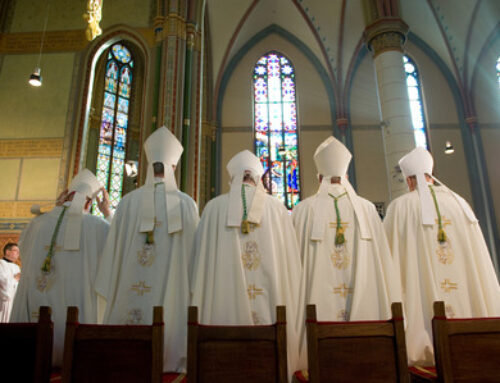 Part I: Having affected the lives of half the members of the human race in innumerable ways for millennia, the denigration of women is clearly the greatest single injustice in human history and continues to be a stain on culture and religion alike. Part II and Part III: The Church has contributed to the denigration of women. The key to correcting this mistake lies in Christ’s commandment to love one’s neighbor.
Part I: Having affected the lives of half the members of the human race in innumerable ways for millennia, the denigration of women is clearly the greatest single injustice in human history and continues to be a stain on culture and religion alike. Part II and Part III: The Church has contributed to the denigration of women. The key to correcting this mistake lies in Christ’s commandment to love one’s neighbor.
The teachings most powerfully influenced by the Church’s denigration of women concern the purpose of marriage and clerical celibacy.
The question immediately arises: Is it appropriate for Catholics to evaluate issues the Church considers settled? Assuming we are speaking of careful, responsible evaluation, the answer is yes, absolutely, for two reasons. First, God gave each of us a mind to use, especially concerning important issues, and there is no more important issue that our relationship with God and one another. Secondly, Church leaders are human and may therefore err in their judgment of an issue. Later in this essay, I will discuss several significant moral issues on which the Church changed its teaching even after the teaching was considered definitive.
Before examining how the denigration of women has affected marriage and clerical celibacy, we should recall the views of influential Church leaders: Tertullian: “[Women are] the gate to hell.” St. Augustine: “What is the difference whether it is in a wife or a mother, it is still Eve the temptress that we must beware of in any woman… I fail to see what use woman can be to man, if one excludes the function of bearing children.” Saint Albertus Magnus: “One must be on one’s guard with every woman, as if she were a poisonous snake and the horned devil . . . Her feelings drive woman toward every evil, just as reason impels man toward all good.” St. Thomas Aquinas: “As regards the individual nature, woman is defective and misbegotten . . . .”
Because most of these individuals were brilliant, saintly men, their thoughts and attitudes have exerted unparalleled influence on Church leaders over the centuries and guided the development of Church teaching.
Here is the thought pattern that followed from the early Church leaders’ view of women:
Women tempt men to sexual behavior, not only outside marriage but also within marriage. Ideally, men would avoid that temptation even within marriage, but that would require ignoring God’s command to “be fruitful and increase in number.” The solution to this dilemma is to define the primary purpose of marriage as procreation and the secondary purpose as the mutual help of spouses and/or the remedy for sexual desire.
The idea of sex providing mutual help and a remedy for sexual desire suggests that having sex with one’s spouse is an unfortunate condition that needs fixing, a perspective that explains the Church’s historic recommendation of self-denial and chastity as the path to genuine holiness within marriage as well as outside it. (See Pope Paul VI, Humanae Vitae, paragraph 21).
The above thought pattern is not only evident in the Church’s teaching on marriage, but also in the (Western) Church’s requirement of priestly celibacy. In this case, the thought pattern can be expressed as follows:
Because married men engage in coitus not only to carry out the biblical command to procreate, a noble function, but also to satisfy their sexual desire, they are especially vulnerable to the blandishments of “Eve the temptress” (Augustine’s phrase), whose “feelings drive [her] toward every evil” (Albertus Magnus’ phrase). Therefore, married men should be barred from ordination or at least required to practice continence within marriage.
Some parts of these thought patterns are directly expressed in the Church’s teachings on marriage and the priesthood. Other parts are implied. In the latter case they may exist more at the level of attitude than of conscious thought, a fact which helps to explain why the Church has never acknowledged that its traditional view of women is an irrational stereotype that challenges the truth that women, no less than men, are created in the image and likeness of God.
For centuries, Church leaders ignored the impact of the Church Fathers’ view of women on Church teachings. Instead, they focused on refining arguments that support the teachings. In the case of marriage, for example, they have argued that artificial interference in the coital act to prevent procreation is unnatural and therefore immoral. And in the case of the priesthood, they have argued that the priesthood requires a man’s full attention, which married men cannot give because of their obligations to their wives and children. (The latter argument is seriously weakened by the fact that married priests in Eastern Rites have met their priestly obligations for centuries.)
Consider for a moment how different the Church’s views on these matters would be if the Church Fathers had taken a kinder view of women. Suppose they had taught that men and women are equally prone to sin, equally capable of leading others into sin, and equally capable of resisting sin for the love of God. Suppose, too, that the Fathers had taught that sexual intercourse is a wonderful gift from God that helps married couples maintain their emotional and spiritual intimacy.
Had that been the case, I submit that the Church’s views on marriage and clerical celibacy would likely have been as follows:
Marriage. Marriage is the union of a man and a woman ordained by God and characterized by three forms of love: friendship (philia), sexuality (eros), and benevolence (agape). If a married couple wish to become parents, and God blesses that wish, they are responsible for raising the child (children) to love God and neighbor.
Note that procreation is part of this formulation but the dominant part is conjugal love.
Clerical Celibacy. The Church has always regarded celibacy as a noble choice for priests; the Roman Church has even required it. Nevertheless, marriage is not necessarily an impediment to priestly service. Indeed, because (like Holy Orders) it is a sacrament founded in love, it can enhance that service.
Of course, to speak of what might have been is relatively easy. To demonstrate that it can be, however, is more challenging. The main obstacle is the deeply embedded belief that the Catholic Church cannot change its view on matters it has classified as settled—that is, closed to discussion and debate.
History disproves that belief. As the distinguished historian John T. Noonan Jr. has documented in “Development in Moral Doctrine” (Theological Studies 54, 1993), the Catholic Church has dramatically changed its teachings on such significant issues as usury, slavery, and religious freedom over the centuries. (See also his extended analysis of the matter in A Church that Can and Cannot Change, University of Norte Dame Press, 2005.)
Usury: Noonan writes: “ . . . From at least 1150 to 1550, seeking, receiving, or hoping for anything beyond one’s principal—in other words, looking for profit—on a loan constituted the mortal sin of usury. The doctrine was enunciated by popes, expressed by three ecumenical councils, proclaimed by bishops, and taught unanimously by theologians.” Although that teaching has never been formally rescinded, no member of the hierarchy has supported it for several centuries.
Slavery: Noonan notes that “once upon a time, certainly as late as 1860, the Church taught that it was no sin for a Catholic to own another human being; to command the labor of that other human being without paying compensation; [also] . . . to sell him or her for cash [and] to do the same [with] his or her offspring.” Moreover, many distinguished Catholic thinkers accepted slavery, including St. Paul, St. Augustine, Pope Gregory I, Justinian, and St. Thomas Aquinas. Moreover, Pope Gregory owned slaves, as did the Maryland Province of the Society of Jesus. Today, of course, the Church holds the opposite view of slavery, “excoriating it as evil.”
Religious Freedom: In St. Augustine’s time, Noonan points out, the Church approved forcing heretics to return to the faith or suffer execution by secular authorities. Centuries later, St. Thomas Aquinas concurred. Only in 1964 at Vatican II did the Church not only denounce that practice but also affirm, in Noonan’s words, “that freedom to believe was a sacred human right . . . founded on the requirements of the human person . . . conveyed by Christian revelation . . . [and] taught from the beginning by Jesus and his Apostles, who sought not to coerce any human will but to persuade it.“ Noonan adds that some at the Council protested that “the teaching of the magisterium was being abandoned [and] they cited express texts and hitherto unchallenged papal statements” to support their contention.
As Noonan’s historical analysis makes clear, the Church has changed its teachings, even when its earlier views were considered definitive and therefore unchangeable.
A more recent example than those cited by Noonan is the Church’s position on Galileo. In 1616 a special commission of theologians concluded that Galileo’s idea that the earth moves around the sun is “foolish and absurd in philosophy, and formally heretical since it explicitly contradicts in many places the sense of Holy Scripture . . . .”
Accordingly, Pope Paul V then ordered that Galileo be instructed “to abandon completely . . . the opinion that the sun stands still at the center of the world and the earth moves, and henceforth not to hold, teach, or defend it in any way whatever, either orally or in writing.”
Three hundred seventy-six years later, Pope John Paul II acknowledged the Church’s error in the Galileo case. He wrote:
Thanks to his intuition as a brilliant physicist and by relying on different arguments, Galileo, who practically invented the experimental method, understood why only the sun could function as the [center] of the world, as it was then known, that is to say, as a planetary system. The error of the theologians of the time, when they maintained the centrality of the Earth, was to think that our understanding of the physical world’s structure was, in some way, imposed by the literal sense of Sacred Scripture. . . .
In making this acknowledgment, John Paul not only showed great humility, but also great faith in God. Over the centuries many Church leaders have reasoned that their admission of error in this (or any other) serious matter would cause scandal, undermine Catholics’ faith in God, and even deny the workings of the Holy Spirit. That did not happen with John Paul’s admission. People were instead relieved and grateful. Most, I believe, also understood that the Holy Spirit did not fail to offer insight; rather, humans failed to comprehend it.
The world’s favorable reaction to John Paul’s admission was not an oddity. As John Noonan argues, neither judicial authority nor scientific authority is diminished by the admission of error. Indeed, such an admission is regarded as a mark of integrity,
Refusing to admit an error does not eliminate it—rather, it compounds it, and the longer the delay, the more difficult the task and the more extended the negative consequences. I submit that the Church’s denigration of women cries out for acknowledgment and correction, and I pray that Church leaders will have the humility, courage, and faith to answer that cry.
Copyright © 2014 by Vincent Ryan Ruggiero. All rights reserved



